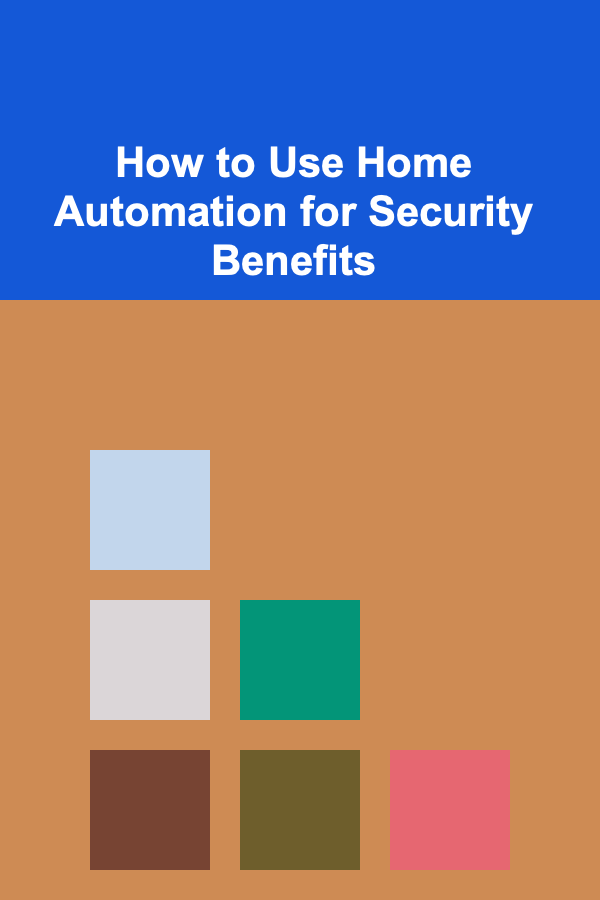
How to Use Home Automation for Security Benefits
ebook include PDF & Audio bundle (Micro Guide)
$12.99$5.99
Limited Time Offer! Order within the next:

Home security has become an increasingly important concern for homeowners in today's world. With the rise in crime rates and the advancement of technology, securing one's home is no longer just about locks and alarms. Home automation has emerged as a powerful tool that integrates various security devices into a cohesive system, providing enhanced protection and peace of mind. This article explores how homeowners can effectively use home automation technologies to boost their home security, covering essential components, integration methods, best practices, and future trends.
Understanding Home Automation
2.1. What is Home Automation?
Home automation refers to the use of technology to control and manage various systems within a home, including lighting, heating, ventilation, air conditioning (HVAC), security, and appliances. These systems can be controlled remotely via smartphones, tablets, or computers, allowing homeowners to manage their homes conveniently from anywhere.
2.2. Evolution of Home Automation Technology
The concept of home automation dates back several decades, starting with basic remote controls and programmable thermostats. However, advancements in wireless technology, artificial intelligence, and the Internet of Things (IoT) have revolutionized the field. Today's smart devices can communicate with each other, learn homeowner preferences, and provide real-time updates, making home automation smarter and more efficient than ever before.
The Importance of Home Security
3.1. Statistics on Home Burglary
According to the FBI, a burglary occurs every 26 seconds in the United States, with homes being the primary target for thieves. In many cases, homes without security systems are up to three times more likely to be broken into. This alarming trend highlights the need for effective security measures, especially those that leverage modern technology.
3.2. Common Security Challenges
Homeowners face various security challenges, including:
- Unauthorized Entry: Many intruders gain access through unlocked doors and windows.
- Vandalism: Properties without visible security measures are often targeted for vandalism.
- Environmental Threats: Fire, carbon monoxide, and water leaks pose risks to home safety.
These challenges underscore the necessity for comprehensive security solutions that go beyond traditional methods.
Key Components of Home Automation for Security
4.1. Smart Locks
Smart locks replace traditional keys with digital access methods, such as smartphone apps, key codes, or biometrics.
- Benefits :
- Remote locking and unlocking
- Temporary access codes for guests or service personnel
- Activity logs tracking who enters and exits
4.2. Security Cameras
Modern security cameras provide high-definition video feeds that can be accessed remotely.
- Features :
- Night vision capabilities
- Motion detection alerts
- Two-way audio communication
4.3. Motion Sensors
Motion sensors detect movement in designated areas and can trigger alarms or notifications.
- Types :
- Passive infrared (PIR) sensors
- Microwave sensors
- Dual-technology sensors (combining both PIR and microwave)
4.4. Alarm Systems
Smart alarm systems can be integrated with various sensors and cameras, providing a comprehensive security solution.
- Components :
- Door/window sensors
- Glass break detectors
- Sirens and alerts
4.5. Smart Lighting
Smart lighting can be programmed to mimic occupancy, deterring potential intruders.
- Applications :
- Scheduling lights to turn on and off at specific times
- Utilizing motion-activated lights for pathways and entryways
Integration of Home Automation Devices
5.1. Home Automation Hubs
A home automation hub acts as the central controller for all connected devices, ensuring seamless communication.
- Examples :
- Amazon Echo
- Google Nest Hub
- Samsung SmartThings
5.2. Compatibility and Connectivity
When choosing devices, homeowners should consider compatibility with their existing systems.
- Protocols: Devices may use different communication protocols, such as Z-Wave, Zigbee, or Wi-Fi. Ensuring compatibility is crucial for a smooth integration process.
Creating a Comprehensive Security Plan
6.1. Assessing Vulnerabilities
Conduct a thorough assessment of your home to identify potential vulnerabilities.
- Considerations :
- Entry points (doors, windows, garage)
- Unlit areas that could hide intruders
- Proximity to neighboring homes
6.2. Choosing the Right Devices
Based on the vulnerability assessment, select devices that address specific security needs.
- Example: If you have multiple entry points, a combination of smart locks and surveillance cameras may be ideal.
6.3. Setting Up Notifications
Configure notifications for critical events, such as unauthorized entry or sensor activations.
- Options :
- Push notifications to smartphones
- Email alerts
- Integration with local law enforcement (if applicable)
Best Practices for Using Home Automation for Security
7.1. Regular Maintenance and Updates
Keeping devices updated ensures they operate efficiently and securely.
- Tasks :
- Update firmware regularly
- Replace batteries for sensors and cameras
- Test alarm systems periodically
7.2. User Education
Educate all household members on how to use home automation devices effectively.
- Training Topics :
- How to lock/unlock smart locks
- Accessing camera feeds
- Responding to security alerts
Case Studies of Effective Home Automation for Security
8.1. Case Study 1: The Smith Family
The Smith family upgraded their security system by implementing smart locks, cameras, and motion sensors. After experiencing a near-burglary incident, they decided to invest in a comprehensive home automation system.
-
Implementation:
- Installed smart locks on all exterior doors
- Set up security cameras with live feeds accessible via smartphones
- Integrated motion sensors around the property
-
Results:
- Increased peace of mind
- Deterrence of potential intruders
- Ability to monitor the home while traveling
8.2. Case Study 2: Urban Apartment Security
In an urban apartment setting, the Johnsons faced challenges with package theft and unauthorized access. They opted for a tailored home automation solution.
-
Implementation:
- Utilized a smart intercom system for package deliveries
- Installed indoor security cameras to monitor common areas
- Set up smart lighting to simulate occupancy during absences
-
Results:
- Reduced instances of package theft
- Enhanced sense of community safety
- Greater control over access to shared spaces
Future Trends in Home Automation and Security
As technology continues to evolve, we can expect several trends to shape the future of home automation and security:
- AI-Powered Security: Artificial intelligence will enhance threat detection capabilities, enabling systems to differentiate between normal activity and potential security threats.
- Integration with Wearable Technology: Wearables may allow users to manage home security directly from their devices, providing real-time alerts and access control.
- Improved Interoperability: As more manufacturers embrace open standards, devices from different brands will work seamlessly together, enhancing user experience.
- Focus on Privacy and Data Security: With increased connectivity comes the need for robust data protection measures, ensuring that personal information remains secure.
Conclusion
Home automation offers powerful tools for enhancing home security, providing homeowners with the convenience and peace of mind they desire. By integrating smart locks, cameras, sensors, and lighting, individuals can create a comprehensive security plan that addresses their specific needs. As technology continues to advance, leveraging these innovations will become increasingly vital in safeguarding our homes against potential threats. Investing in home automation for security is not just about protecting possessions; it's about creating a safe environment for families to thrive.
Reading More From Our Other Websites
- [Polymer Clay Modeling Tip 101] From Primary to Perfection: How to Create Endless Shades with Polymer Clay
- [Personal Care Tips 101] How to Choose a Body Spray for Women: A Comprehensive Guide
- [Metal Stamping Tip 101] Why Metal Stamping Is Revolutionizing Modern Electronics Manufacturing
- [Scrapbooking Tip 101] Step-by-Step Guide to Creating Your First Photo Collage Layout
- [Home Family Activity 101] How to Turn Your Family "Simon Says" Game into an Active Learning Experience
- [Star Gazing Tip 101] How to Use Smartphone Star Charts for Real‑Time Navigation
- [Home Soundproofing 101] How to Soundproof Your Home for Music Practice or Recording
- [Home Family Activity 101] How to Craft Themed Clues for an Unforgettable Home Scavenger Hunt Experience
- [Organization Tip 101] How to Store Foam Rollers Without Taking Up Too Much Space
- [Home Storage Solution 101] How to Create a Highly Functional and Aesthetically Pleasing Kitchen Utensil Storage System

How to Create a System for Managing Home Maintenance Tasks
Read More
How to Install a DIY Home Security System on a Budget
Read More
How To Learn to Troubleshoot Instrument Issues
Read More
How to Build a Space Observatory
Read More
How to Monitor Your Credit Card Activity for Suspicion
Read More
10 Tips for Building a High-Performing QA Team
Read MoreOther Products

How to Create a System for Managing Home Maintenance Tasks
Read More
How to Install a DIY Home Security System on a Budget
Read More
How To Learn to Troubleshoot Instrument Issues
Read More
How to Build a Space Observatory
Read More
How to Monitor Your Credit Card Activity for Suspicion
Read More